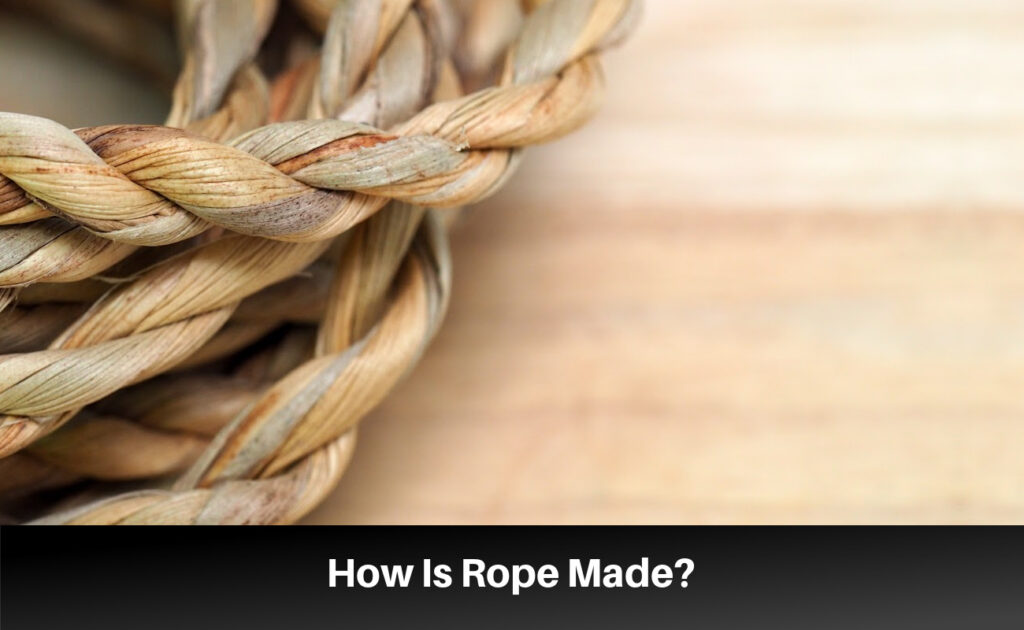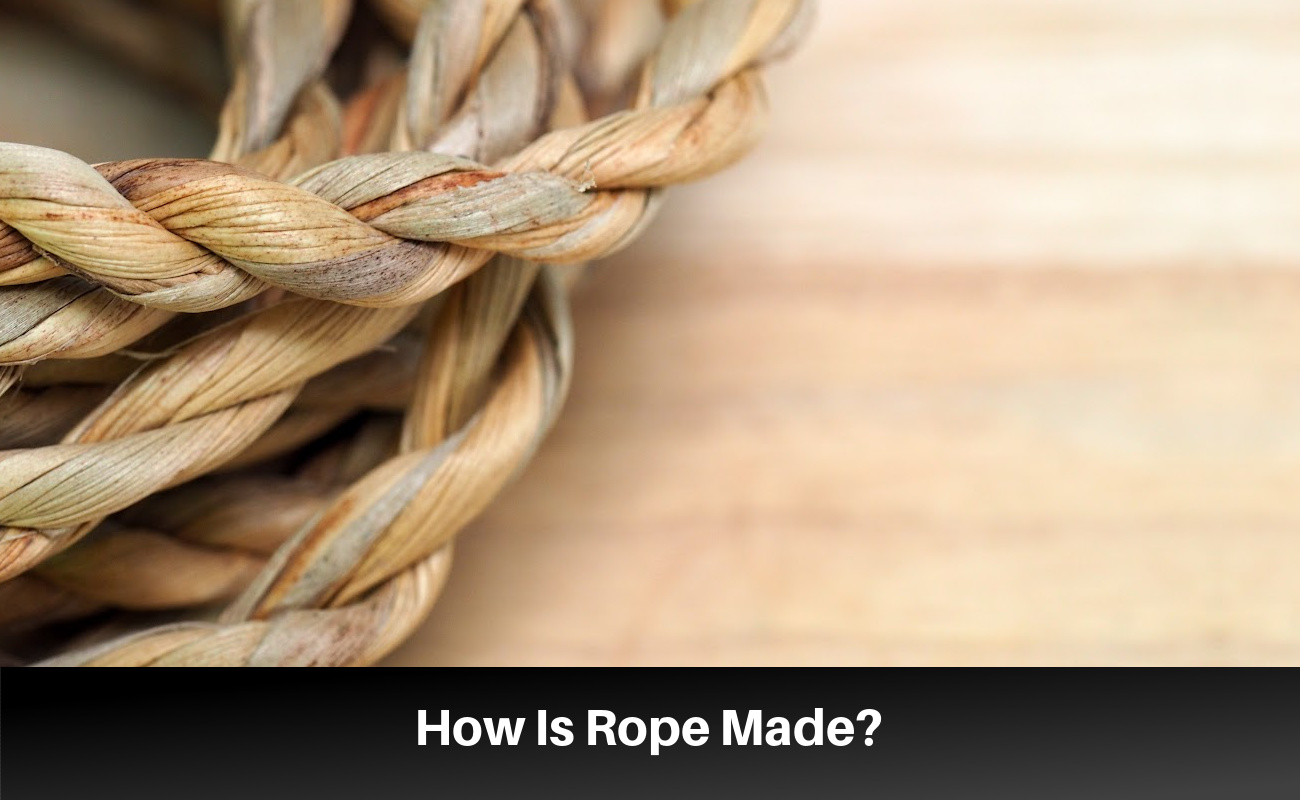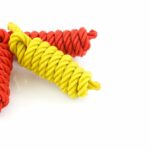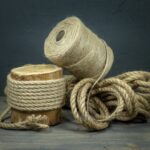A rope comprises natural or synthetic fibers or filaments that are braided, plaited, or twisted to create a stronger structure. The materials and construction determine their strength, flexibility, and capabilities.
People were twisting ropes by hand for thousands of years before we invented rope-making machines.
The uses of rope include:
- Boat and marine applications
- Exercise
- Camping
- Backpacking
- Decorating & Crafting
- Pets
- Gardening
- Hoisting
- Bearing Weight
- Securing
What Is A Rope?

A rope is a combination of fibers, wires, or filaments. The components are twisted or braided together to create rope. Rope must remain compact but stable while in use and safe to use even while being twisted, bent, or pulled.
“the texture and the nature of a rope is determined by the colour, fineness, stiffness, strength, and stretchability of the fibres or filaments used in its construction.”
What Is Rope Made Of?
A rope may comprise many materials, either natural or manufactured. Natural materials include cotton, manila, hemp, jute, or sisal.
Synthetic rope fibers made from metals or polymers contain filaments. The filaments are necessary to the structure of the entire rope. Such properties make it easier to create a stiffer rope. Synthetic materials use thicker filaments, resulting in a more rigid rope.
Natural fiber ropes do not contain these filaments throughout the entire length. They deteriorate more quickly because of mold growth. Synthetic ropes deteriorate because of excessive exposure to sunlight, chemicals, and high temperatures.
Rope Material
- Cotton is the softest natural rope fiber, making it stretchier than the other fibers. But, it is also the weakest.
- Jute is a type of natural fiber that comes from the jute (corchorus) plant. Jute has a tough consistency and is versatile enough to make it popular in crafting.
- Coir is also known as coconut fiber and comes from the outer husk of the coconut.
- Sisal rope comes from natural fibers from the sisal hemp (Agave sisalana) plant. It is like manila rope but isn’t as strong.
- Manila rope is a natural fiber from the manila hemp (abaca) plant. Manila is a strong fiber less likely to degrade when exposed to the elements.
- Hemp rope comes from the fibers of the hemp plant. Like manila rope, it is solid and resistant to weather damage.
- Polypropylene rope comes from a durable polymer. It is resistant to chemicals and has a high melting point.
- Nylon is the strongest rope material for everyday usage. It is stretchy and absorbs large shock loads.
- Polyester rope is almost as strong as nylon but doesn’t stretch or absorb shock loads well. It is resistant to sunlight and abrasions.
- Polyethylene ropes are strong but lightweight. They are softer than other synthetic ropes but have high wear resistance.
- Dyneema ropes are the most robust artificial rope. It is 15 times stronger than steel but is light enough to float on water.
How Is Rope Made?
A person must first prepare the fibers or filaments for spinning. The fibers or filaments spin into yarn and further spin into cords. A person or machine then twists the cords into strands, then three to four strands are twisted into a rope.
For years, people made ropes inside buildings called “ropewalks.” Ropewalks are long and low, and a rope’s length depends on building size. It’s rare, but some still use rope walks, primarily for demonstrations.
Rope Making Machines
Machines called “formers” or “bunchers” create strands. Then, the strands go into a compression tube, where a revolving flyer twists them into a rope. Foreturn flyers rotate strand bobbins which are cylinder-shaped spindles. Next, the capstan flyer pulls the strands, and the receiving flyer turns the rope. How long the rope can be depend on the capabilities of the flyer.
Some machines don’t need a receiving bobbin in their flyer. They are horizontal, and there are strand bobbins inside the flyer. The strands are pulled off their bobbins. Then they are overtwisted and combined with the other strands to create a rope.
How To Make Cordage From Grass
Rather than buying rope, you can make your own. You can use long natural fibers like grass, tree bark, woody plant stalks, or certain leaves and roots.
Next, you’ll begin creating your rope. How you do this depends on what kind of rope you’d like to make.
You’ll hold all the grass fibers together for a basic wrapped rope. Roll the whole bundle against something hard in a single direction. Repeat the movement all down the length of the fibers to create a rope.
To braid, you will overlap three or more strands to create the braid. As you go, you’ll need to add extra pieces. You can also add knots as you work the braid to strengthen the rope.
How To Make Rope From Hemp
The steps are mostly the same as above, but for non-grass materials, you need to “work” the materials. “Working” involves shredding the fibers into strands that are easy to work. You can work materials by pounding them with a rock, stripping them, or twisting them. Sometimes, you’ll need to soak the material to make it easy to work with.
What Is Rope Used For?
Ropes are used for:
Marine Applications
People use ropes on ships and boats to hold down anchors, tie-down boats, rig sails, and other marine applications. You can use ropes as rescue devices and netting for fishing as well.
Most ropes erode over time from contact with water. Polypropylene is the ideal rope for marine applications because it’s light enough to float and doesn’t absorb water, so it doesn’t erode.
Exercise
Ropes are popular for exercises like Crossfit. The heavy material is excellent for building strength and burning calories.
Healthline explains why ropes are great for exercise:
“Battle ropes target most of the muscles in your body, including those in your abdominals, shoulders, arms, upper and lower back, and lower body.
If you’re looking to target a specific area, you can change how you swing the ropes.
For example, bilateral waves (swinging the ropes with both arms at the same time) better target the erector spinae muscles, while unilateral waves (alternating arms) target the external obliques more effectively.
One study found that performing battle rope exercises three times per week for 6 weeks led to significant improvements in upper body and core strength.”
Katey Davidson, MScFN, RD, CPT, Healthline.com
Camping/Backpacking
Ropes have a multitude of uses when you’re camping and hiking. You can use rope to mark trees along your path, tie down your tent, or hang your supplies in trees out of reach of bears. You can even use ropes to create a hammock that you can relax in at your campsite.
Emergencies happen in the wilderness. Ropes can help support a person until you can get them genuine medical care. You can create a makeshift splint with sticks and rope to help a broken bone or sprained ankle. You can also use a rope to make a tourniquet if you have enough medical knowledge.
Sometimes, a day hike might end in an emergency, or your tent gets damaged, and you have no shelter. A simple rope combined with a tarp can offer life-saving protection.
Decorating & Crafting
Ropes are popular for decorating homes and creating crafts. Macrame is a craft where you weave soft cotton rope into intricate patterns. You can also use rope to make jewelry, line a picture frame, or wrap around a basket. Rope is also suitable for upholstery in outdoor furniture.
Gardening/Landscaping
Plants aren’t always the best at supporting themselves. Gardeners often use ropes to tie plants to a support structure. You can also create a makeshift fence out of rope to protect your garden from animals.
You can also place ropes around your yard. You can make a decorative walkway, netting, or plant pot holders.
Towing
A strong rope is excellent for towing large vehicles out of unideal situations. Towing companies use ropes to get vehicles onto the back of their trucks. You can also keep a strong rope in the back of your car if you get stuck in mud or snow.
Weight-Bearing
Ropes are excellent for hanging things in your shed, garage, balcony, or elsewhere.
Securing
Ropes are great for tying down items and preventing them from getting loose. Use ropes to anchor your items, big and small.
For Fun
You can use ropes to create an obstacle course, maze, crawling nets, or rope jungles for kids or children at heart.
Pets
Ropes are typical for use with pets because they’re so durable. Products made with ropes are great for larger dogs who are tough on their toys and equipment. Rope leads are often stronger than traditional leads.
FAQs
What Is The Strongest Rope For Pulling?
Nylon is the strongest rope material for pulling. It is the most robust manufactured rope material for everyday uses. It is the stretchiest and the best at bearing heavy loads. Arborists use nylon for pulling down trees.
How Much Does Rope Cost?
How much a rope costs depends on the material and length; rope is generally sold by the foot. Cheaper materials may sell for only a few dollars, while higher-quality ropes may go for over $100.
How Much Weight Can A Nylon Rope Hold?
How much weight a nylon rope can hold depends on the thickness and construction. Twisted nylon can hold the most weight. A 0.5-in twisted nylon rope can bear up to 520 lbs, while a 0.25-in twisted nylon rope can only hold up to 120 lbs.
Braided nylon can’t hold enough; a 0.5 in rope can hold up to 320 lbs, while a 0.25 in rope can only hold up to 90 lbs.





